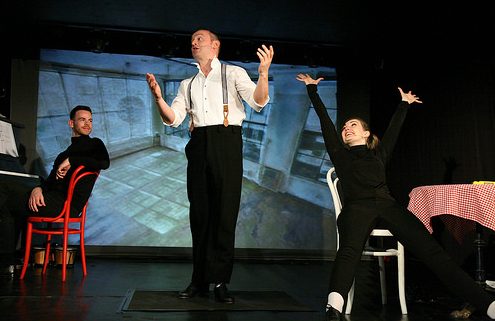The scenario for Tap Dancing with Jean-Paul Sartre requires a total suspension of belief, as the world’s greatest dancer, the most beautiful woman and the most influential philosopher, meet, dance and discuss philosophy in 1950s Paris. This short play from playwright James Runcie and director Marilyn Imrie is promoted as a “musical comedy about existentialism” (in itself something of a misnomer). Whilst there are some enjoyable elements, the resulting mélange fails to hit the mark on some levels.
Astaire and Hepburn are supposedly making a film together and Sartre stumbles upon them rehearsing. Cue some discussion about the philosophy of life and dance, before Sartre invites Hepburn to dinner. Astaire poses as a waiter, disguised by an impossibly pendulous moustache. He eavesdrops on the Hepburn/Sartre dialogue and makes the odd – and mildly amusing – quip. It’s unclear why Sartre doesn’t recognise him, but his presence does add some entertainment to what is otherwise a rather turgid scene. Sartre continually hits on Hepburn, in between expounding existentialism.
The staging, costumes and music do a good job setting the scenes and evoking the Rive Gauche of Paris, 1956. Ashley Smith as Audrey Hepburn certainly looks the part in a black combo, and is particularly skilful in the slow-motion dance scene. Yet her relationship with Astaire and Sartre seems somewhat stilted, and the written character lacks the fragility that Hepburn reflected in real life. Darren Brownlie’s Fred Astaire is suitably debonair and almost paternalistic towards Hepburn. Astaire and Hepburn are both foils for the main man– Jean-Paul Sartre, played by Kevin Lennon as something of a comic roue. He raises a few laughs with comments such as “I’m a Marxist, I have two left feet” and imbues the character with a lot of personality and a cheeky French accent. Yet he too seems something of a caricature, and throughout the play the inter-relationships and overall scenario fail to convince.
Brownlie should be commended for the choreography, especially given the limited stage space inhibits as much dancing as the title promises. The production concludes with a final performance of the main musical number It Don’t Mean a Thing (If It Ain’t Got That Swing) in front of Sartre’s students (ergo the audience). Thankfully this provides an opportunity to experience a little more song and dance, even though it all feels too little, too late.
